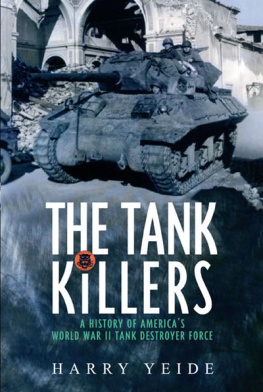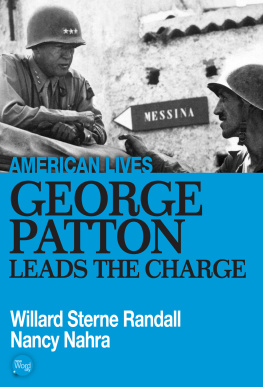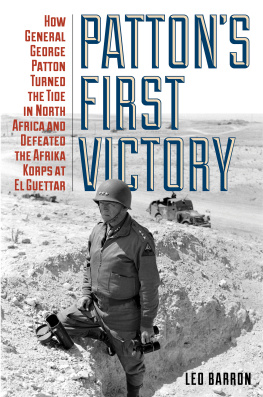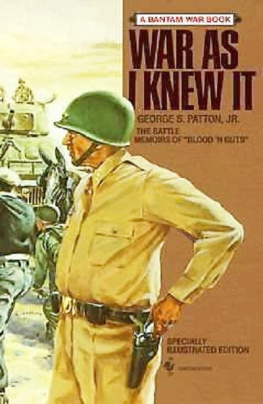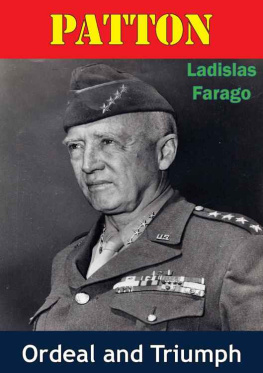Fighting Patton
George S. Patton Jr.
Through the Eyes of His Enemies
Harry Yeide

To Bob Ovelmen, who is the master
of the other fellows point of view.
Contents
Preface
Seeing the battle through the opponents eyes is the most dramatic way of seeing it. It is different in one important respect from looking at it through the opposite end of the telescope. For instead of being minimized, the picture is magnifiedwith startling vividness.
B. H. Liddell Hart
M ANY BOOKS HAVE BEEN WRITTEN about Gen. George S. Patton Jr. This is the book that hasnt.
I have exploited vast and entirely new resources to reveal Pattons story through the eyes of his enemies. No published history of Patton that I could find reveals the identity of the German units that fought him in the St. Mihiel salient and Meuse-Argonne or what those soldiers experienced. Yet I tracked down those documents, some of which are still as crisp as when they were first placed in filing boxes, at all echelons of command, ranging from army-group level down to the battalion level. Those documents revealed who commanded the machine guns that shot at Patton at Pannes when he advanced alone on foot with a tank. I have used hundreds of unpublished accounts by German officers to show you the great American general through their eyes. I have burrowed through the original battle accounts of Pattons future enemies on the eastern front to explain why they learned to fight the way they did. I found the reports that prove when the Germans found out Patton was in Normandy and how, and I have tapped the telephone transcripts to put the reader in the command tent of the German army in France. Although we fought alongside our French allies during the latter half of the Second World War, I also located the diary of the man who commanded the French troops at Port Lyautey and who almost defeated Lucian Truscott and the left-most landing of Pattons Western Task Force in Morocco during the opening hours of Operation Torch in November 1942.
Who were the men who waged war against George S. Patton Jr.? What were the military experiences that shaped their methods of war, and how they would perceive their enemy, Patton? How did they interpret the quality of his actions on the battlefield? How much did they even know about what he was up to? This work answers these questions.
Although the thrust of this book is the enemys perspective on Patton and his battles, Patton had the advantage of fighting most of them under conditions in which his side held the initiative. The narrative, therefore, often begins with the world as seen from the American perspective.
One runs into the problem of the Patton myth, stories that have spread through the literature without much effort to ascertain their veracity, such as the tale of Adolf Hitler calling Patton that crazy cowboy general. Of the major works on Patton, Ladislas Faragos Patton: Ordeal and Triumph strikes me as particularly riddled with idiosyncratic and hagiographic interpretations of Pattons achievements, such as a dramatic retelling of Patton advancing alone into the Hindenburg Line at St. Mihiel and depositing his silk tankers flag there. There is no way to prove a negative, but I do highlight incidents about which no authoritative source, who would have been present at the supposed events, has a thing to say or cases where timing renders the story improbable.
I intend this work in no way to detract from the achievements of the fighting men in the 1st Tank Brigade, the Western Task Force, II Corps, Seventh Army, and Third Army who fought under Patton and were justifiably proud of their achievements. They won. Their enemies lost. But the enemies perspectives on the how and why of those outcomes, influenced as they may be by self-justification and missing information, completes the picture of the events and makes it whole. Readers may be surprised to discover how little they learn about the enemy if they peruse most works on George S. Patton Jr.
It may not be apparent to the casual reader, but it is darn hard to tell exactly what happened these many years ago. Contemporary reports written by separate participants in any given incident are likely to differ, sometimes substantially. Later accounts introduce additional flaws of memory and self-justification. One of Pattons enemies, Generalfeldmarschall Albert Kesselring, wrote after the war, Distortion of military history begins the moment the battalion adjutant sharpens his pencil in the trenches.... [A]t this very moment, the objective opinion of the writer of the combat report is expressed and, consciously or unconsciously, for good or for questionable motives, The reader should be aware that the tale offered here is merely as close as I can get.
I have taken small liberties with texts drawn from the military records and personal accounts, correcting grammatical errors and spelling mistakes and introducing consistency in references to unit designators, equipment, dates, and so on. I have generally used the local names for places, but I have used name variants familiar to English-speaking readers for features such as the Rhine and Moselle Rivers. Maps use standard NATO unit symbols where appropriate.
Harry Yeide
June 2010
Acknowledgments
I WOULD LIKE TO THANK my wife, Nancy, who is first in my book and makes me better in every endeavor, including this one. She helped ease me through a few trying moments.
Mark Reardon at the U.S. Army Center of Military History was, as always, generous with his assistance; he provided key information on the 10th Panzer Division, reviewed the manuscript, and offered helpful comments. Alexander Zeisberg went above and beyond the call to obtain a document from the Bundesarchiv. Thanks also to Mark Stout, who directed me to great material on Ultra and deception operations involving Patton. Likewise, Andy Rawlins opened my eyes to the rich resources of the George C. Marshall Foundation.
I would also like to thank the cheerful and efficient public servants at the U.S. National Archives and Records Administrations document, microfilm, still-photo, and moving-image reading rooms in College Park, Maryland, and Washington, D.C. The taxpayer is getting a good deal.
ONE

From Kid to Killer
G ENERAL GEORGE S. PATTON JR. lost his life on 21 December 1945 as a legend, praised in retrospect as an armored commander even by a defeated enemy. Pattons daring and leadership had few equals among the Allied warlords, and some of his triumphs were magnificent. He earned his place in military history and popular lore. But was he really, as one of his most knowledgeable biographers, Martin Blumenson, suggested, a hero even to professional German officers who respected him as the adversary they most feared in battle? What did his mortal enemies really make of Patton and his skills as a combat commander?
How might an enemy come to know of and judge Patton as a military adversary? A man might meet him personally on the battlefield, close enough to look him in the eyes and see the sweat on his brow. Such meetings are rare in modern warfare, yet one antagonist briefly knew Patton in that way. Patton believed fervently in leading in combat from the front, and so an enemy might not see him as an individual on a faceless battlefield, yet know his hand from the tactical and moral performance of men under his command. To the extent that Patton could shape a plan executed by his subordinates, an enemy would learn his ways through the daring and conception of his schemes.
Next page

